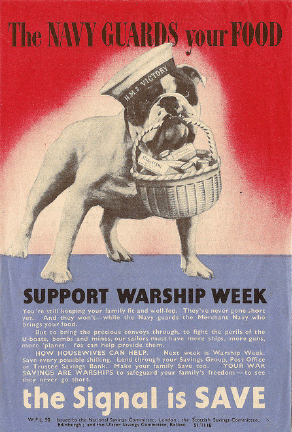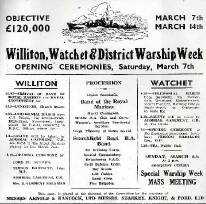WARSHIP WEEK 1942 - WATCHET & WILLATON
The National Savings Movement (1916-1978) was a British savings scheme deigned to encourage individuals to invest their hard-earned money in Bonds, allowing the governments to fund budget  deficits and wartime expenditure. Facilitated through a network of Trustee Savings Banks and Post Office Savings Banks, the rates of interest given were low but backed by the security of government bonds for peace of mind.
deficits and wartime expenditure. Facilitated through a network of Trustee Savings Banks and Post Office Savings Banks, the rates of interest given were low but backed by the security of government bonds for peace of mind.
The outbreak of war in 1939 was to bring with it an added importance for the movement, which grew rapidly as thousands of new savers enrolled to do their bit for the war effort. The movement’s posters could be seen o almost every street corner, encouraging everyone to ‘Lend to Defend their Right to be Free or to fight off the ‘Squander Bug”. Annual Local Savings Weeks became a part of wartime life, carrying names such as War Weapons Week (1941), Warship Week (1942) Wings for Victory (1943) and Salute the Soldier (1944). Often echoing the pre-war carnivals and fetes, these weeks encouraged the individual to invest whilst allowing them the opportunity to let their hair down at a time when there was little to celebrate.
Each themed Savings Week was organized in a similar fashion. Each local savings committee was allotted a target (based on head of population). This target was, as well as being a monetary amount, often expressed as items of military equipment equal to the amount to be raised - £5,000 for a Spitfire during Wings for Victory Week for example. At the close of the week those committees who had reached or broken their target were rewarded with plaques, scrolls and the like.
At 2.30pm, on Saturday 7 March 1942 the districts of Williton and Watchet launched their warship Week with a ceremonial march through Williton, led by a band of the  Royal Marines and with the salute taken by Admiral Casement CB. The opening ceremony was performed at 3.15pm by Lord St Audries (President of the local effort), Admiral (retired) J M Casement CB, Vernon Bartlet MP, and Mrs D Clement Salaman (Chairman of the area Warship Week Committee).
Royal Marines and with the salute taken by Admiral Casement CB. The opening ceremony was performed at 3.15pm by Lord St Audries (President of the local effort), Admiral (retired) J M Casement CB, Vernon Bartlet MP, and Mrs D Clement Salaman (Chairman of the area Warship Week Committee).
A similar scene was repeated at Watchet a little over one hour later. It was announced that the target for the district had been set at a challenging £120,000, enough to adopt the destroyer HMS Tetcott
By the close of the week the final amount realised stood at a little over £100,500 – almost £15,000 short of the target. In May, the district received confirmation that, as a result of their efforts made during the Warship Week campaign, the area would adopt HMS Tetcott as previously discussed, and arrangements were to be made to exchange plaques, one from the district to the ship and another - of the ship’s badge - to be displayed in the local Council Chambers. Today, the ship’s badge is housed within Holsworthy Museum, generously donated in 2005 by Watchet Town Council.
Lieutenant Rycroft was to keep in regular contact with both Tetcott and the district of Williton and Watchet, sending occasional updates on the events and operations in which 'their' ship had been involved: whilst the inhabitants of the Devon and Somerset villages provided numerous comforts and treats for those aboard.
To read about the Village of Tetcott and the Hunt which was to give its name to the ship,
click HERE